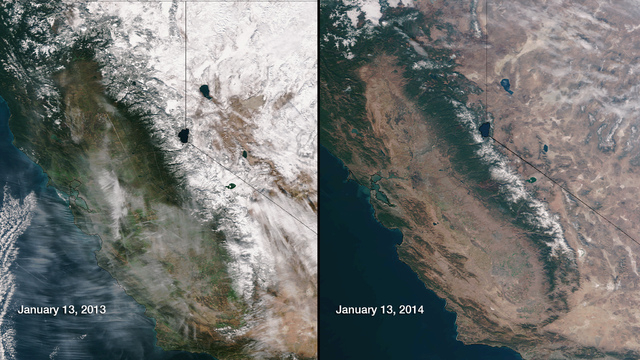Water shortage in California town stokes fears

WILLITS, Calif. — In this small logging town in Northern California’s redwood country, small blue signs urging water conservation are almost everywhere you look.
Just south of Willits, in one of the state’s most verdant corners, crows and other birds peck at dry ground that should be covered in water at the city’s Centennial Reservoir, which is less than a third full. The creek that feeds it has slowed to a trickle.
“It’s common at this time of year for the water to be going over the cement wall right here. In fact, we’d be standing in water,” said Bruce Burton, a Willits city councilman, gesturing toward the small cement dam in the creek. “In the 20 years I’ve been in local government, we’ve never experienced this kind of condition.”
Though some rain was falling Thursday and predicted to last through the weekend in the north and central parts of the state, California remains in the midst of an historic drought. The state’s Department of Public Health says 17 rural areas including Willits — a town of about 5,000 people that usually sees about 50 inches of rain a year — are dangerously low on water, and officials expect that number to grow.
In addition to declaring a drought emergency, California has canceled water deliveries beginning in the spring from the state’s water system to farms and thirsty cities and shut down fishing in dozens of streams to protect imperiled salmon and steelhead.
The emergency has become a disruption to everyday life in Willits, a Mendocino County locale known as the final resting place of the racehorse Seabiscuit. City leaders have banned lawn watering and car washing, mandated all residents cut water use dramatically and asked restaurants to serve the precious resource only upon request and to conserve, such as by using paper plates.
Adrienne Moore, Willits city manager, said some relief is expected from the current storm.
“But we would need several similar storms to really pull us out of this drought crisis,” he said.
While California sees cycles of drought normally, scientists say the dry weather since Oct. 1 appears to be unique in its severity.
“According to tree ring records, this water year, which began Oct. 1, really stands out as one of the worst single years in the last 500 years,” said Lynn Ingram, author of “The West Without Water” and a University of California earth science professor.
“This year, the drought is impacting places more than we’ve ever seen, at least that I’ve come across in my research,” she added.
Of the 17 water-starved rural agencies, three are in rainy Mendocino County and are districts that rely largely on rainwater to fill their reservoirs. Other areas include parts of Fresno, Kern and Santa Cruz counties.
After a record dry 2013, Mendocino County leaders were the first in California to declare a drought emergency, which they did on Jan. 7.
Things are so scarce that the sheriff’s office is on alert for water bandits. During the 2009-10 drought, authorities caught thieves pumping water from Lake Mendocino into trucks. The reservoir is currently about 37 percent full, according to county officials.
“Water theft is a big concern, so we’re doing public announcements and have a line to call for reports to the Sheriff’s Department,” said Carre Brown, a Mendocino County supervisor. “All deputies are on the watch.”
Unlike many of the other communities facing water woes, Willits doesn’t have readily accessible groundwater.
Officials are racing to develop two groundwater wells within city limits, but the water in both sources is polluted by naturally occurring arsenic and other minerals, so the city needs an expensive treatment facility to make it potable. The state public health department is testing the water to help determine what kind of treatment is needed.
Ron Owens, a spokesman for the state public health department, said officials are helping struggling towns like Willits identify other water options, like connecting with other water systems if need be. It also has some emergency funding available.
Meantime, officials say people in the bucolic town seem to be following the mandatory conservation orders.
Even the coin-operated car wash is only offering recycled water.
“We have been rationing severely. No plants get watered. That’s over. Turned off the toilet. I haven’t washed my hair for two weeks,” said Willits resident Andrea Onstad, who was washing her car Monday afternoon.
A few blocks down at Gribaldo’s diner on the city’s Main Street, customers sat at tables with no water glasses. A sign on the wall warned of the drought emergency — water was only available upon request.
The water shortage has changed everything for people in Willits — even how they spend their free time at home.
At Jim Harden’s house, his lawn is splotched with brown spots, and empty flower pots usually stuffed with colorful annuals are stacked high. He’s even unhooked his drip irrigation system.
“We’re very concerned. If we totally run out of water, what are we going to do? Go to another community?” Harden, 78, said, standing in his small greenhouse. “It’s frightening.”
———
Jason Dearen can be reached at http://www.twitter.com/JHDearen